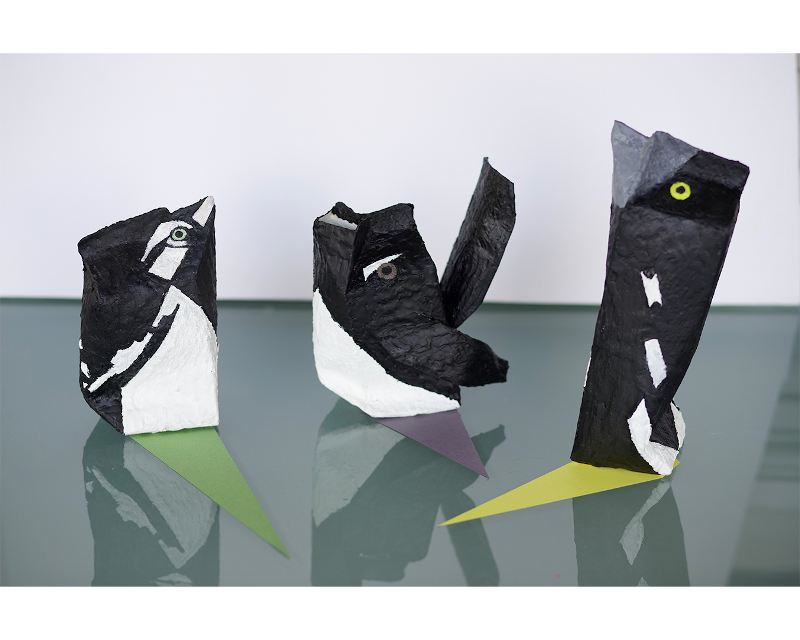
Image credit: Madeleine Kelly, Canberra Birds 2019, encaustic wax and pigment on cardboard, dimensions variable
Unlikely - Journal for Creative Arts Issue 8:
Birds and Language
Call For Submissions
Proposals Due 15 December 2021
Guest editors: Madeleine Kelly and Jen Valender
Issue 8: Birds and Language
What is it to talk of birds and language? How might such a question provide the impetus and grounds for an interdisciplinary encounter between the natural sciences, the humanities, and the creative arts?
The sounds birds make form structured series, comprised of complex syntaxes, nuanced in tone, precise, sometimes excessive, often regarded as being of compelling aesthetic value. We do not hesitate to refer to many of these sounds as songs, or, more prosaically, calls. We move, easily, too, towards thinking about these sounds as a species of language.
More, we readily speak of the visual rhetoric of birds: ideas of performativity, display, mimesis and deception. We sometimes dare to think of birds as artists—not only singers, but bricoleurs, assembling extravagant, colour-coded nests, as in the case of the bowerbird. More recently, we have become more comfortable with thinking of some birds as capable of higher-order reason, as experiments with crows demonstrate capacities to think through and solve complex physical problems.
Themes
This issue responds to themes presented at the Birds and Language Conference hosted by the University of Sydney, its companion exhibition at Wollongong City Gallery, and beyond. Proposals may explore bird species, mimicry, display, the bird song/call dichotomy, or non-human animal music-like practices.
Contributions might include, but are not limited to:
- Anthropological zoosemiotics: how do birds and humans communicate with each other?
- Questions of ethological zoosemiotics (animal behaviour)
- Speculative approaches to understanding and presenting the colours and forms found on birds as a form of encoded knowledge.
- Synchronous and sequential temporalities between birds and non-birds.
- Understandings of systems that stress interdependence, and which model processes of interspecies sympoiesis.
- What is it like to be a bird? How has this question been taken up in aesthetic practices?
- Avian aesthetics: how are our phenomenological experiences of birds in tension with the languages of empiricism?
- The semantics of birdsong: birdsong and parallels to human and non-human language.
- Birds as ambassadors for a geopolitics of sensing and knowing.
- Escaping the Anthropocene: how a critical aesthetic of birds may open a space for restorative reflection.
- Conservation and biodiversity.
We are inviting submissions of:
- Theoretical papers, essays and scholarly articles: 4000-6000 words.
- Creative essays and non-traditional research, which may incorporate images, sound, video, multimedia, poetry, short fictional prose: 2000-3000 words.
- Documentation of art pieces or performances with an accompanying scholarly commentary contextualising the work through the theme Birds and Language: 2000-3000 words.
- Audio or multimedia pieces: max 10 minutes with supporting statement of up to 1000 words.
- Interviews: 2000-3000 words.
Researchers in the humanities (particularly musicology), creative arts, science, and other relevant interdisciplinary fields are encouraged to apply. Final scholarly submissions should be in English, in MLA format, and sent as a doc(x) file. Texts should be between 2000-6000 words including works cited.
Process
Fill out the Submittable form specifically outlining your proposed contribution (250 words) in terms of both the thematic focus, and its proposed form via this URL: https://slamsydney.submittable.com/submit/207034/unlikely-journal-for-creative-arts-issue-8-birds-and-language.
All submissions should be accompanied by a biographical note on the applicant, no longer than 100 words, noting recent key achievements such as publications, awards, grants, residencies, prizes, press coverage or degrees. The editors will respond, inviting selected contributors to develop their proposal into a full submission to be peer reviewed.
Please include your email address and contact number. You will be contacted via personal email regarding the outcome of your proposal, not by the Submittable system. Also, please ensure that your support material is labelled in the exact format below before uploading:
- Primary Contact Name - Name of material submitted (i.e., JohnSmith_Proposal)
Timeline
- Submission of proposal: 15 December 2021
- Notification of acceptance: 15 January 2022
- Submission of draft: 1 May 2022
- Peer-reviewing complete, sent to authors for changes: 1 July 2022
- Final submission: 15 August 2022
- Expected publication: 1 November 2022
Contact
For any queries or to discuss proposed contributions please contact directly:


